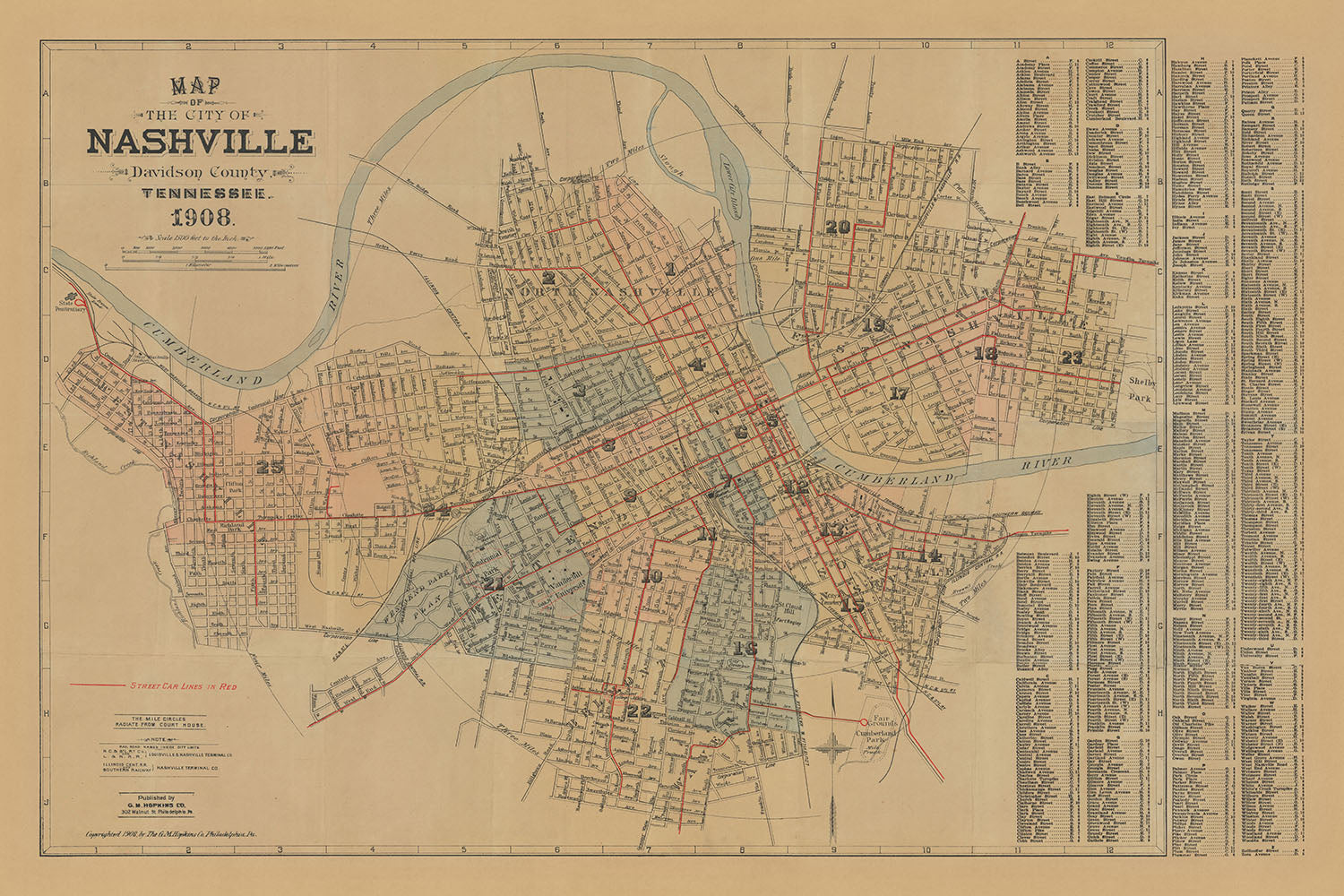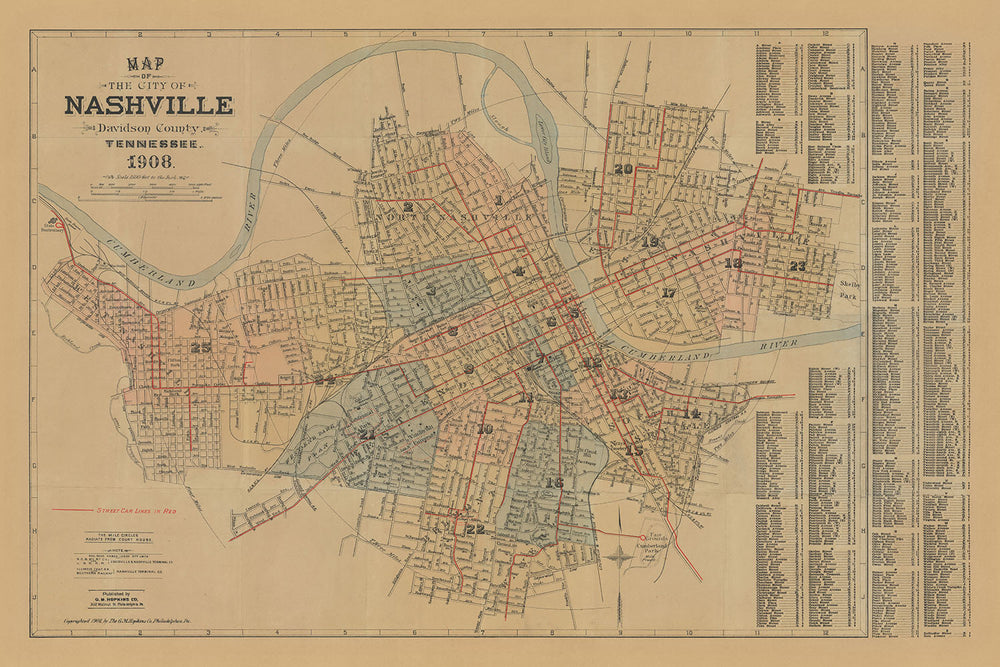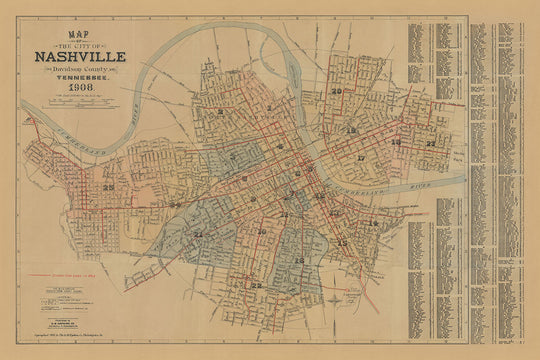- Handmade locally. No import duty or tax
- FREE worldwide delivery
- Love it or your money back (90 days)
- Questions? WhatsApp me any time
Own a piece of history
5,000+ 5 star reviews


Embark on a historical journey through the heart of Tennessee with the "Map of the City of Nashville, Davidson County," crafted in 1908 by the esteemed mapmaker G.M. Hopkins. This exquisite piece not only serves as a testament to Hopkins' dedication to precision and detail but also encapsulates a pivotal moment in Nashville's evolution. Known for his meticulous city maps across the United States, Hopkins' work on Nashville offers a unique bird's-eye view of the city, presenting a vivid tableau of its streets, landmarks, and the bustling life of the early 20th century. This map, with its hand-colored lithographic print, invites admirers to explore the intricate layout of Nashville, from the Cumberland River's meandering path to the distinguished Vanderbilt University, showcasing the city's growing prominence in the region.
The map delineates an array of neighborhoods, including North, South, East, and West Nashville, along with the vibrant Downtown area, each colored by precincts for easy navigation. Noteworthy is the inclusion of street car lines in striking red, illustrating the city's early public transportation network that connected its citizens to the heart of Nashville. The map's attention to such details not only reflects the urban planning of the time but also provides a glimpse into the daily lives of Nashvillians, making it a fascinating artifact for both historians and enthusiasts of urban development.
Landmarks of historical and cultural significance are prominently featured, with Centennial Park, Belmont College, Shelby Park, and Vanderbilt University circled in red, drawing the viewer's eye to these pivotal sites. The presence of the Tennessee State Capitol, Ryman Auditorium, and The Parthenon within this cartographic masterpiece underscores Nashville's rich heritage and its role as a center of education, governance, and entertainment. These landmarks, captured in their nascent stages, offer a rare opportunity to visualize the city's architectural and societal landscape during a time of rapid growth and transformation.
Moreover, the map's comprehensive directory of streets and businesses serves as a valuable resource, painting a detailed picture of Nashville's commercial and residential districts. This aspect not only enhances the map's utility for historical research but also enriches the narrative of Nashville's development, highlighting the city's economic vitality and the diversity of its community. The inclusion of railroads within the city limits, named and meticulously plotted, further accentuates Nashville's significance as a transportation hub, facilitating trade and travel in the burgeoning South.
In essence, the "Map of the City of Nashville, Davidson County" by G.M. Hopkins is more than a mere cartographic document; it is a portal to the past, offering a rich, immersive experience of Nashville at the dawn of the 20th century. Its remarkable detail, combined with the artistry of its design, makes it an invaluable piece for collectors, scholars, and anyone drawn to the allure of historical maps. As a luxury item, this map not only adorns a space with its visual appeal but also serves as a conversation piece, inviting viewers to delve into the fascinating story of Nashville's growth and the meticulous craft of mapmaking.
Streets and roads on this map
- 1st Avenue
- 1st Street
- 2nd Avenue
- 2nd Street
- 3rd Avenue
- 3rd Street
- 4th Avenue
- 4th Street
- 5th Avenue
- 5th Street
- 6th Avenue
- 6th Street
- 7th Avenue
- 8th Avenue
- 9th Avenue
- 10th Avenue
- 11th Avenue
- 12th Avenue
- 13th Avenue
- 14th Avenue
- 15th Avenue
- 16th Avenue
- 17th Avenue
- 18th Avenue
- 19th Avenue
- 20th Avenue
- 21st Avenue
- 22nd Avenue
- 23rd Avenue
- 24th Avenue
Notable Features & Landmarks
- Cumberland River
- Tennessee State Capitol
- Ryman Auditorium
- Vanderbilt University
- The Parthenon
- Shelby Park
- Centennial Park
- Overton Park
- Radnor Lake
Historical and design context
- Mapmaker/Publisher: G.M. Hopkins, known for detailed and accurate maps used for planning and development.
- Date: 1908, capturing Nashville during a period of rapid growth.
- Design and style: Lithographic print, hand-colored, drawn in a perspective view showing the city from a bird's-eye view.
- Historical significance: Provides a snapshot of Nashville's layout and landmarks, offering insights into the city's history and development.
Please double check the images to make sure that a specific town or place is shown on this map. You can also get in touch and ask us to check the map for you.
This map looks great at every size, but I always recommend going for a larger size if you have space. That way you can easily make out all of the details.
This map looks amazing at sizes all the way up to 100in (250cm). If you are looking for a larger map, please get in touch.
Please note: the labels on this map are hard to read if you order a map that is 16in (40cm) or smaller. The map is still very attractive, but if you would like to read the map easily, please buy a larger size.
The model in the listing images is holding the 24x36in (60x90cm) version of this map.
The fifth listing image shows an example of my map personalisation service.
If you’re looking for something slightly different, check out my collection of the best old maps to see if something else catches your eye.
Please contact me to check if a certain location, landmark or feature is shown on this map.
This would make a wonderful birthday, Christmas, Father's Day, work leaving, anniversary or housewarming gift for someone from the areas covered by this map.
This map is available as a giclée print on acid free archival matte paper, or you can buy it framed. The frame is a nice, simple black frame that suits most aesthetics. Please get in touch if you'd like a different frame colour or material. My frames are glazed with super-clear museum-grade acrylic (perspex/acrylite), which is significantly less reflective than glass, safer, and will always arrive in perfect condition.
This map is also available as a float framed canvas, sometimes known as a shadow gap framed canvas or canvas floater. The map is printed on artist's cotton canvas and then stretched over a handmade box frame. We then "float" the canvas inside a wooden frame, which is available in a range of colours (black, dark brown, oak, antique gold and white). This is a wonderful way to present a map without glazing in front. See some examples of float framed canvas maps and explore the differences between my different finishes.
For something truly unique, this map is also available in "Unique 3D", our trademarked process that dramatically transforms the map so that it has a wonderful sense of depth. We combine the original map with detailed topography and elevation data, so that mountains and the terrain really "pop". For more info and examples of 3D maps, check my Unique 3D page.
For most orders, delivery time is about 3 working days. Personalised and customised products take longer, as I have to do the personalisation and send it to you for approval, which usually takes 1 or 2 days.
Please note that very large framed orders usually take longer to make and deliver.
If you need your order to arrive by a certain date, please contact me before you order so that we can find the best way of making sure you get your order in time.
I print and frame maps and artwork in 23 countries around the world. This means your order will be made locally, which cuts down on delivery time and ensures that it won't be damaged during delivery. You'll never pay customs or import duty, and we'll put less CO2 into the air.
All of my maps and art prints are well packaged and sent in a rugged tube if unframed, or surrounded by foam if framed.
I try to send out all orders within 1 or 2 days of receiving your order, though some products (like face masks, mugs and tote bags) can take longer to make.
If you select Express Delivery at checkout your order we will prioritise your order and send it out by 1-day courier (Fedex, DHL, UPS, Parcelforce).
Next Day delivery is also available in some countries (US, UK, Singapore, UAE) but please try to order early in the day so that we can get it sent out on time.
My standard frame is a gallery style black ash hardwood frame. It is simple and quite modern looking. My standard frame is around 20mm (0.8in) wide.
I use super-clear acrylic (perspex/acrylite) for the frame glass. It's lighter and safer than glass - and it looks better, as the reflectivity is lower.
Six standard frame colours are available for free (black, dark brown, dark grey, oak, white and antique gold). Custom framing and mounting/matting is available if you're looking for something else.
Most maps, art and illustrations are also available as a framed canvas. We use matte (not shiny) cotton canvas, stretch it over a sustainably sourced box wood frame, and then 'float' the piece within a wood frame. The end result is quite beautiful, and there's no glazing to get in the way.
All frames are provided "ready to hang", with either a string or brackets on the back. Very large frames will have heavy duty hanging plates and/or a mounting baton. If you have any questions, please get in touch.
See some examples of my framed maps and framed canvas maps.
Alternatively, I can also supply old maps and artwork on canvas, foam board, cotton rag and other materials.
If you want to frame your map or artwork yourself, please read my size guide first.
My maps are extremely high quality reproductions of original maps.
I source original, rare maps from libraries, auction houses and private collections around the world, restore them at my London workshop, and then use specialist giclée inks and printers to create beautiful maps that look even better than the original.
My maps are printed on acid-free archival matte (not glossy) paper that feels very high quality and almost like card. In technical terms the paper weight/thickness is 10mil/200gsm. It's perfect for framing.
I print with Epson ultrachrome giclée UV fade resistant pigment inks - some of the best inks you can find.
I can also make maps on canvas, cotton rag and other exotic materials.
Learn more about The Unique Maps Co.
Map personalisation
If you're looking for the perfect anniversary or housewarming gift, I can personalise your map to make it truly unique. For example, I can add a short message, or highlight an important location, or add your family's coat of arms.
The options are almost infinite. Please see my map personalisation page for some wonderful examples of what's possible.
To order a personalised map, select "personalise your map" before adding it to your basket.
Get in touch if you're looking for more complex customisations and personalisations.
Map ageing
I have been asked hundreds of times over the years by customers if they could buy a map that looks even older.
Well, now you can, by selecting Aged before you add a map to your basket.
All the product photos you see on this page show the map in its Original form. This is what the map looks like today.
If you select Aged, I will age your map by hand, using a special and unique process developed through years of studying old maps, talking to researchers to understand the chemistry of aging paper, and of course... lots of practice!
If you're unsure, stick to the Original colour of the map. If you want something a bit darker and older looking, go for Aged.
If you are not happy with your order for any reason, contact me and I'll get it fixed ASAP, free of charge. Please see my returns and refund policy for more information.
I am very confident you will like your restored map or art print. I have been doing this since 1984. I'm a 5-star Etsy seller. I have sold tens of thousands of maps and art prints and have over 5,000 real 5-star reviews. My work has been featured in interior design magazines, on the BBC, and on the walls of dozens of 5-star hotels.
I use a unique process to restore maps and artwork that is massively time consuming and labour intensive. Hunting down the original maps and illustrations can take months. I use state of the art and eye-wateringly expensive technology to scan and restore them. As a result, I guarantee my maps and art prints are a cut above the rest. I stand by my products and will always make sure you're 100% happy with what you receive.
Almost all of my maps and art prints look amazing at large sizes (200cm, 6.5ft+) and I can frame and deliver them to you as well, via special oversized courier. Contact me to discuss your specific needs.
Or try searching for something!















































